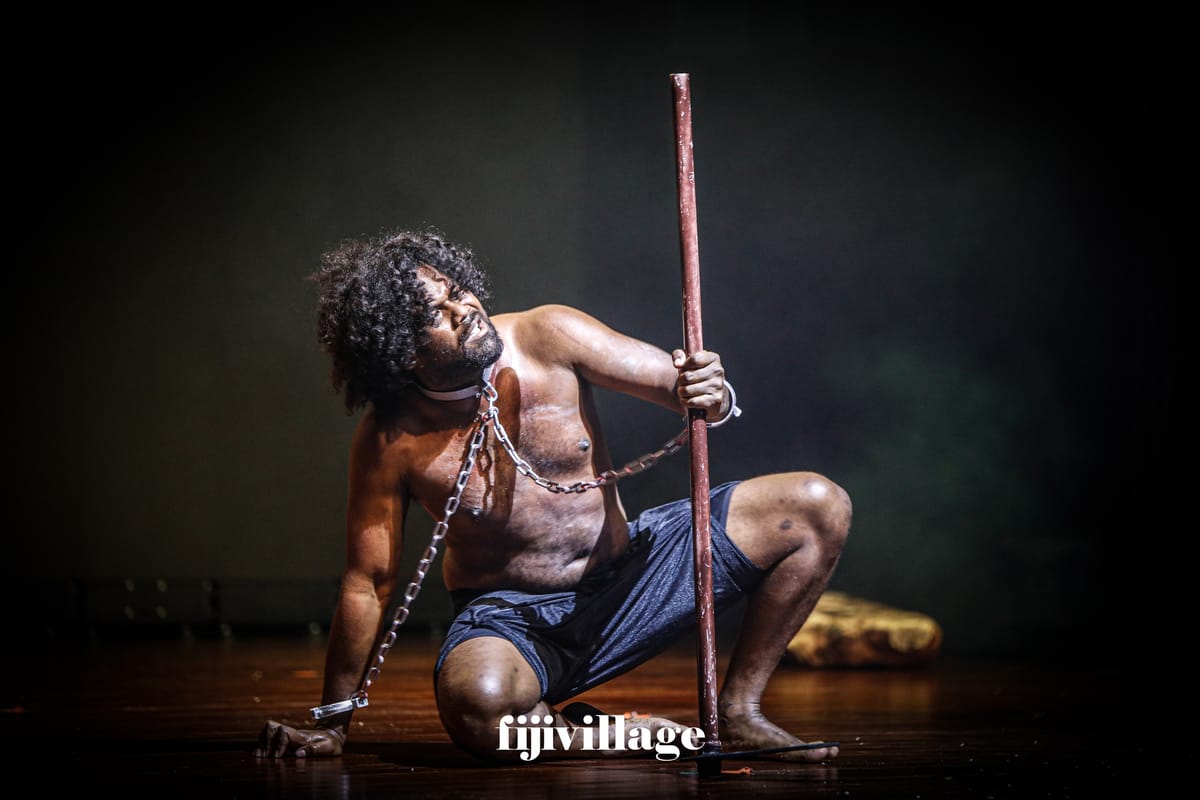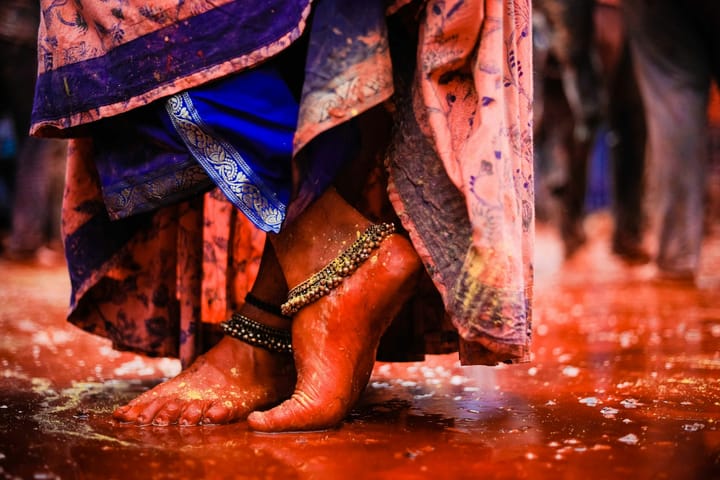Part 3 of 4: Pacific Blackbirding - A Spectacle of Historical Persistences
The jewel in the crown in Butakoci (Stolen) is its Melanesian Blackbirding sequence. Draunibaka’s treatment of the case study is surprisingly tender. While her curatorial hand is evident in all vignettes, there is a discernible elevation in this sequence.

A REVIEW: BUTAKOCI (STOLEN) — A Musical Theatre Production on Human Trafficking in Fiji
AUTHOR: Mary Rokonadravu
DISCLOSURE OF INTEREST STATEMENT: This is an Independent Review. I am not associated with any organisation, institution, company, artists or employees directly associated with the production. This Review is not a Commissioned piece of writing.
“To be an artist is to believe in life.” — Henry Moore
The jewel in the crown in Butakoci (Stolen) is its Melanesian Blackbirding sequence. Draunibaka’s treatment of the case study is surprisingly tender. While her curatorial hand is evident in all vignettes, there is a discernible elevation in this sequence.
The tenderness is palpable even through its high-energy phases. It takes consummate skill and artistic depth to achieve this. But perhaps, skill is not the right word. Since intuition is key to gaining artistic depth, and intuition cannot be taught; only imbibed under a lifelong apprenticeship with life; and through constant, hard confronting of oneself, perhaps intuition is a better word. This exploration is necessary to understanding the merits of the Melanesian Blackbirding sequence.
READ PART 2 IF YOU MISSED IT


ON BLACKBIRDING
Blackbirding was practiced by Australians and by Europeans (in Fiji). It involved the use of force (kidnapping or abduction) and trickery (fraud) to lure Pacific Islanders to work in sugarcane plantations in Queensland (Australia) and in Fiji.
In the latter case, they worked in cotton and coconut plantations, sugarcane plantations, and in road and railroad construction to pave the way for Indian indenture. 62,000 Islanders were taken to Australia. the numbers in Fiji are unclear. This Human Trafficking was practiced from 1863 to 1911. While there is a clear termination in 1911 and the earliest documented reference is in 1863, it is accepted its start was before 1863.
In official records, the word ‘Polynesia’ was used to categorise the slaves of Blackbirding. ‘Melanesia’ was not used. Neither were individual country or island names used. Collective categorisation under Polynesia, a sub-region failed to define nor encapsulate the identity of any single victim of Blackbirding slavery. The victims of Blackbirding were from the Solomon Islands, Vanuatu (New Hebrides), Gilbert Islands & Line Islands (now Kiribati), Tokelau, Loyalty Islands (part of New Caledonia), and Fiji (to Australia).
The current use of the sub-category Melanesia, and the act of descendants of Blackbirding slavery defining themselves by their specific island and country of origin is a significant act of reclaiming and correcting history.
Read more here on ABC Australia.
Returning to the performance, the Melanesian Blackbirding experience is embodied by Apolonia (Eugene Dakunivosa) whose demise is encapsulated in the sequence. Beginning with railroad cutting in the middle of a sugarcane field, the sequence flips between the past and present, and terminates with the death of Apolonia as he drops onto the stage as lights fade out; and we presume, out of his life as his body hits the ground. The flashbacks present the abduction of Apolonia and others in an unspecified island and their backbreaking work in sugarcane railroad construction in Fiji.
The sequence is a masterpiece for several reasons. These include: music (and song); choreography; performance (Eugene Dakunivosa as Apolonia); sound design (and soundscape); and its triumph — lighting design.
The song ‘Lai Tei Dalo’ (Gone to Plant Taro) headlines the sequence and two lines are used as a refrain in sound design: ‘Votu mai, Votu mai, Votu mai na sitima ni meli — Sa qai voce mai na velovelo’ and ‘Biu tu mai na vanua — votu mai na manua.’ (Trans. in lyrics page below). The lines refer to the appearance or emergence of a blackbirding ship on the horizon, and to the dinghy rowed to shore — the fact of leaving one’s homeland & to the kidnapping of the lyricist (& by proxy, the singer & the viewer).
The sound design choice to embed the chorus (refrain) in music constructs an auditory frame which anchors the viewer within the moment of kidnapping and forceful removal/departure. It is an ingenious technical device that leads to the transfixing of the viewer. The root words for transfix are from Latin: ‘trans’ meaning ‘through’ or ‘across’ and ‘figere’ to fasten or impale, loosely translated to mean making someone ‘motionless’. The song play and its chorus and refrain keep the viewer transfixed at the story’s most emotive point.
Even though the storyline moves back and forth and there is performance to advance the story, one’s subconscious is stuck or impaled in that one auditory moment of a ship’s emergence and the violent act of the kidnapping of a child. This auditory framing is exceptional because subconsciously, the viewer is put through two distinct experiences: living out Apolonia’s life in hard labour and demise; plus the looping of the moment of kidnapping and loss of home and family.
Similar to the nursery rhymes, folk songs, and fairytales for children in other continents, which carry morbid, distressful stories and histories; ‘Lai Tei Dalo’ is also dark and refers to the sinister practice of blackbirding. Similar to the trend of nursery rhymes, lullabies, and children’s folk songs (usually sung by adults also), ‘Lai Tei Dalo’ carries a dark tone as it is an account of a child who is kidnapped by blackbirders.

The lyricist (songwriter) speaks from the point of view of a child. With their father off to the taro garden and mother off fishing, the child ventures into a strange place and is abducted by blackbirders. There is an inventory of actions, symbols, and feelings related to kidnapping and transportation of a minor: vulnerability (temporary normal-day distancing from parents); external perpetrator entering a safe space of domesticity (blackbirders intrude upon safe spaces of local peoples & families); head covered by a [burlap] sack (hooding to disorient & to conceal pathways of possible escape and return); a large ship (material symbol of a more powerful entity); its dinghy rowed to shore (mirroring numerous forms of transport used then and now); and victim resignation to the fate of transportation to slavery in Fiji.
The last line: ‘My name really must be Billy’ speaks to the stripping of identity, the namelessness, associated with the blackbirder's and plantation-owners’ refusal to acknowledge nor use actual names of people in everyday life. Victims of blackbirding were predominantly men and the name Billy evolved into a regularised term or name for male slave labour (Pacific Islander labour) in many plantations in Fiji in that era. The lyricist’s last line points to the locus of identity situated in personal names being violently stripped, and by a seemingly simple, convenient, therefore, acceptable action — refusal to acknowledge a name, a natural progression stemming from an inability to recognise another human being.
The song is laced with grief because it is the voice and point of view of a child or minor. Only a child is exposed to the temporary vulnerability of being left alone with parents gone gardening and fishing. Only a child venturing off ‘to a strange place’, often within the vicinity of their home or community, can be abducted or kidnapped. A child’s view of the world is smaller than adult’s. In an island setting, the mere end of a coastal bay or peninsula is a ‘strange place’ in the world of a child unaccompanied by a parent or adult.
The line, ‘Au gade ki serea’ is not linked to Serea (Naitasiri) in Fiji (as some allude) because the lyrics refer to a place before abduction. Therefore, the Playbill translation, to a strange, ‘a far-off place’ is appropriate in lieu of an exact location. Given the diversity of places that victims of Blackbirding originated from, it could be a place of the same, or similar-sounding name. Blackbirded slaves were from Solomon Islands, Vanuatu, Line Islands, Gilbert Islands, Loyalty Islands, Ellice Islands, among other archipelago countries at the time. The song or children’s rhyme may have been composed by a single poet or singer, then as all oral pieces do, evolved over the last century and a half.
The fact that it is in Vosa Vakaviti Raraba suggests the loss of original Pacific Islands languages and to the utility of absorbing the local indigenous broadly-spoken language by Pacific Islanders — a natural progression, but tragic for the severance of memory and intangible cultural heritage associated with uprooting and loss.
The Melanesian Blackbirding sequence is clever in its use of this familiar children’s folk song as the piece to musically and lyrically render Apolonia’s story. Through its use, Apolonia becomes the original subject (person) of the song, which brings into focus, Eugene Dakunivosa (Apolonia) and Tevita Tobeyaweni (choreographer).
Tobeyaweni’s choreography focuses on the artistic presentation of abduction, hard labour, suffering, and the loss of a life. Depicting Pacific Islander (Melanesian) slave labour breaking rock as part of railroad construction, Tobeyaweni uses pickaxes as a prop to visually underscore the physicality of work. Its accompanying music is robotic and punctuated with pauses. Using flashback, Apolonia’s backstory is highlighted as the scene shifts to the past depicting their kidnapping, hooding, disorienting, and subsequent presence in Fiji. Tobeyaweni places both hard, cutting dance/performance moves and subtle elements to juxtapose the past and present within the sequence.
Phil Dakei and Talei Draunibaka reach their peak technical art in Sound Design and Lighting Design which is the production's highest achievement.
Recommended Citation: Rokonadravu, M., (2024) ‘A Spectacle of Persistent Histories — A Review: Butakoci (Stolen) — A Musical Theatre Production on Human Trafficking in Fiji’, Medium, Suva. Accessed: [Insert Date and Time].
This Review was first published on Medium on 11 August 2024, before the setup of this website.
READ PART 4 OF 4

SKIP TO THE FULL REVIEW



